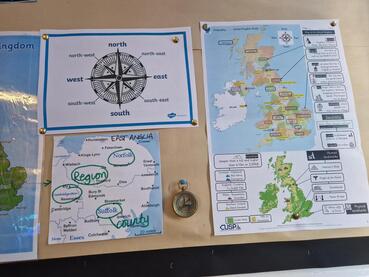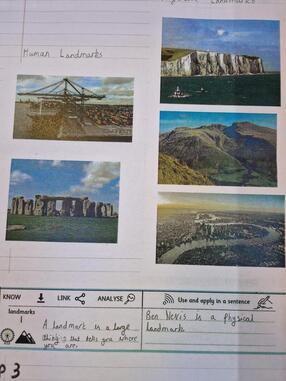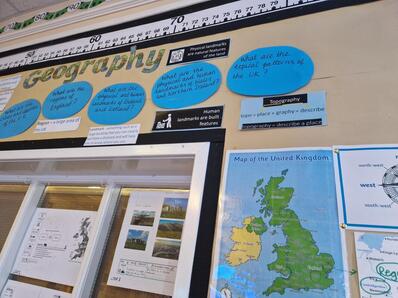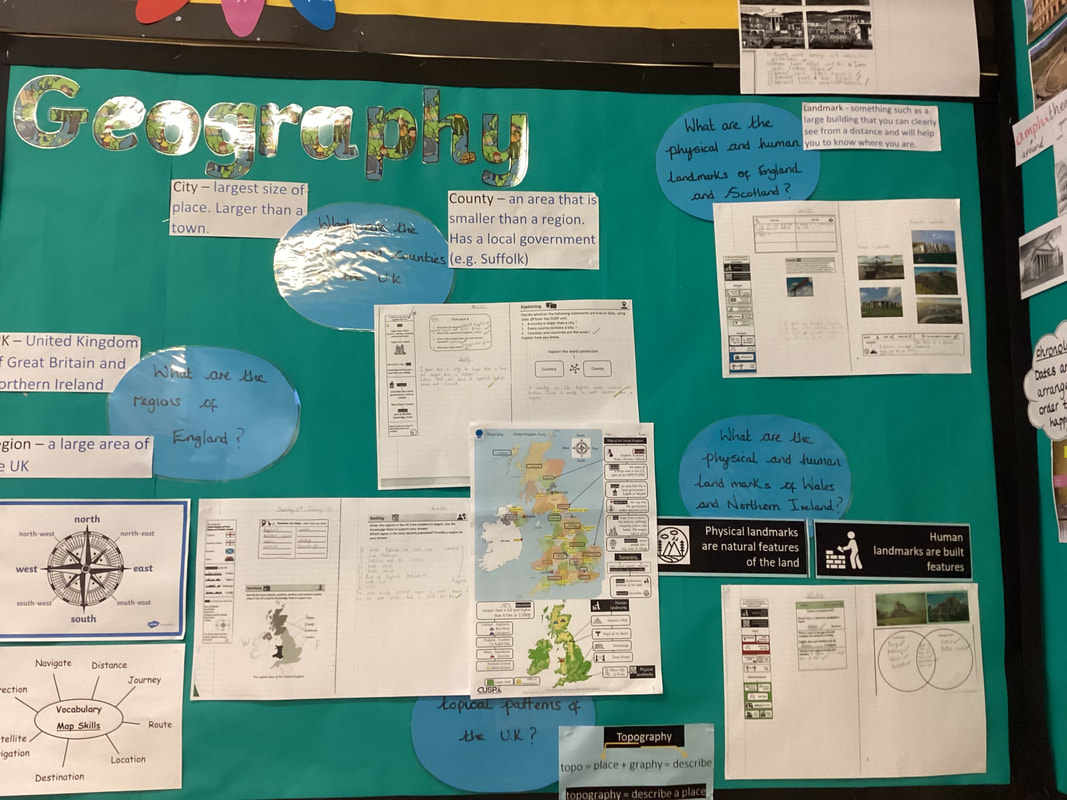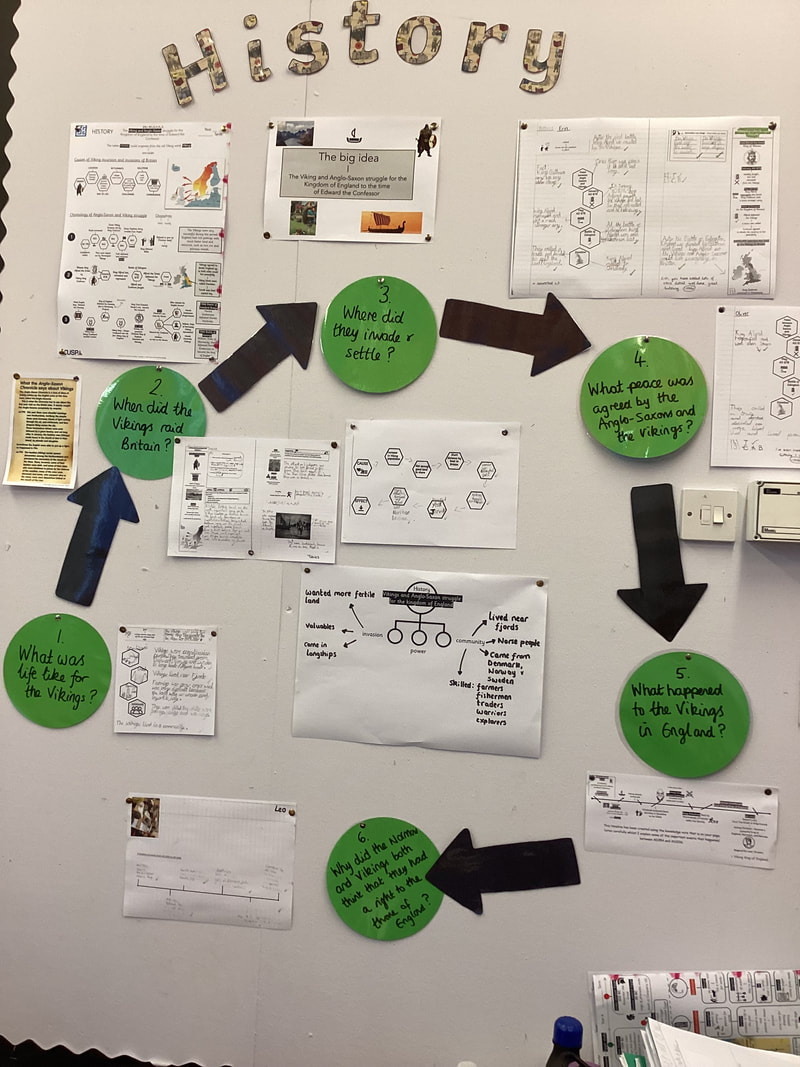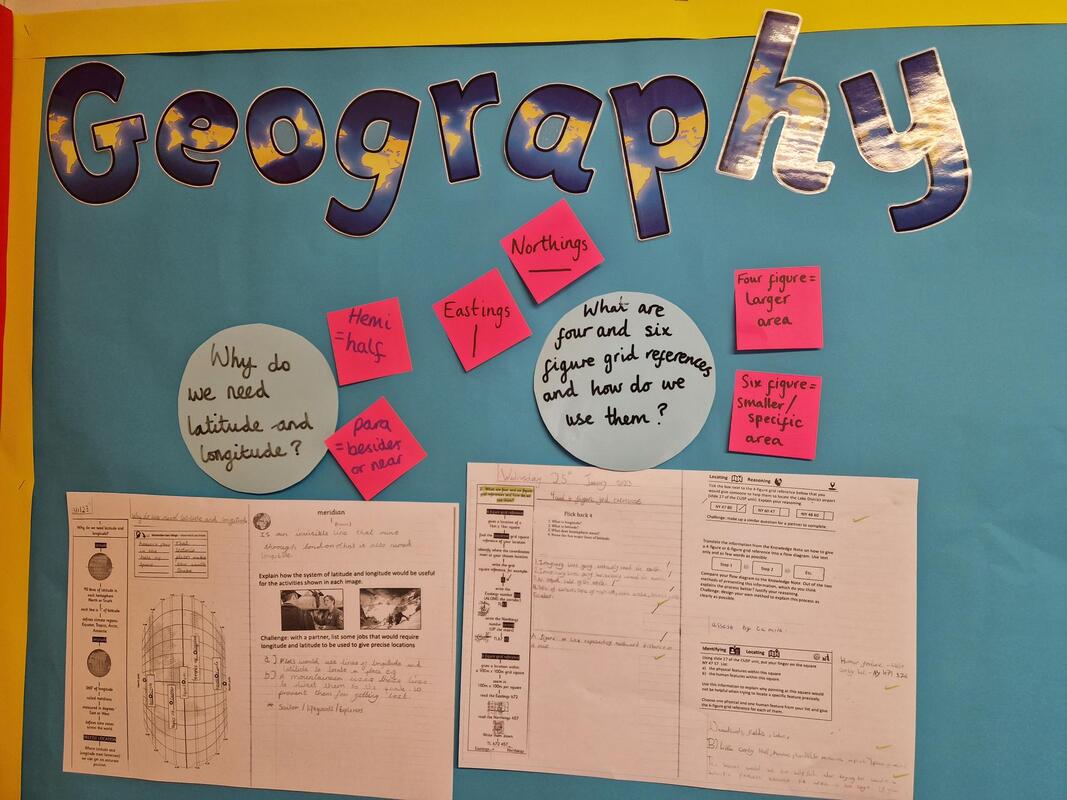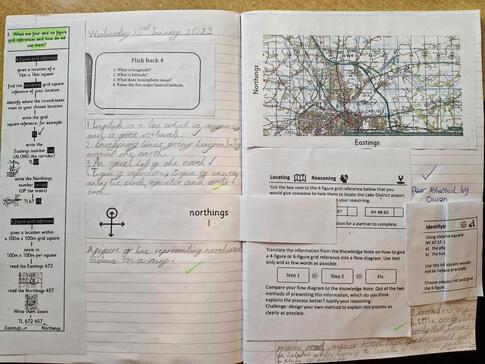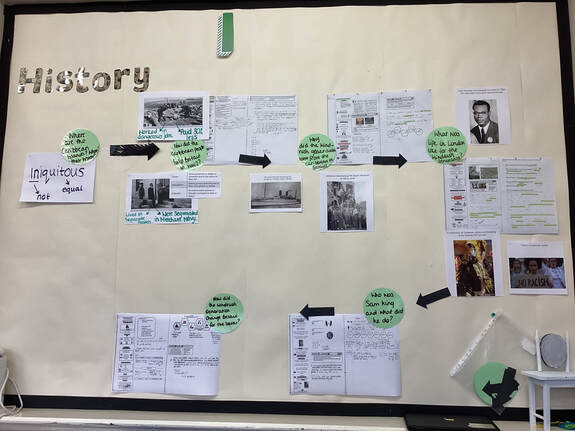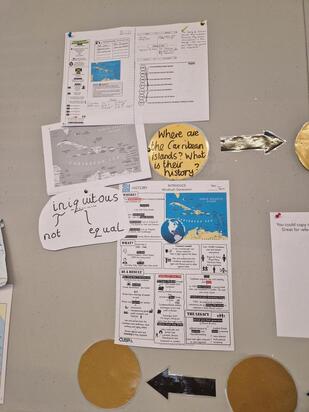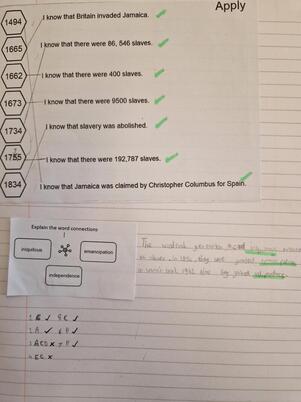What is our aim with History & Geography at Springfield? (Intent)
Our intent is to deliver the content outlined in the History & Geography programme of study within the National Curriculum. In Geography lessons, we inspire in pupils a curiosity and fascination about the world and its people that will remain with them for the rest of their lives. In History, we enable pupils to see themselves in the curriculum and prepare them for life in modern Britain. Pupils will develop a well-rounded knowledge of the past and its events, with intention to improve every pupils’ cultural capital, understanding of the world around them as well as their own heritage.
We aim for pupils to become ‘more expert’ with each study and grow an ever broadening and coherent understanding of the subject. This guards against superficial, disconnected and fragmented historical and geographical knowledge. Specific and associated historical/geographical vocabulary is planned sequentially and cumulatively. A guiding principle of our curriculum is that each study draws upon prior learning. We use the CUSP model curriculum.
What does this look like in our classrooms? (Implementation)
A clear progression of skills is implemented for pupils from Year 3 to Year 6. Skills, knowledge, concepts and vocabulary are continually revisited and are built upon to ensure that pupils make, or exceed, expected progress. Concepts and vocabulary are explicitly taught in context and built upon through each unit of work across the school.
THINKING LIKE A GEOGRAPHER OR HISTORIAN - Pupils make more sense and deeper understanding of the substantive concepts and knowledge by using what they know through disciplinary knowledge. Teachers use ‘Thinking Hard Tasks’ to consolidate or elaborate pupil thinking.
Geography
The implementation of our curriculum ensures balanced coverage of the four main themes outlined in the National Curriculum: Geographic and skills fieldwork; locational knowledge; human and physical; and place knowledge.
History
The curriculum is taught chronologically so that pupils gain an understanding of their place in time and how each historical event ‘fits in’ to the wider context. Our curriculum ensures balanced coverage of the following concepts: community, knowledge, invasion, civilisation, power and democracy.
Within History & Geography sessions we aim to support pupils by:
*Promoting pupil voice
*Displaying learning, skills and vocabulary, in the classroom, on our 'Loops of Learning' wall
*Using an enquiry led approach; key questions and ancillary questions
*Providing a diverse curriculum
*Creating opportunities for pupil to have wider experiences; visits, trips
Vocabulary
Vocabulary forms a key part of our curriculum. Therefore, subject specific Tier 2 and Tier 3 words are identified in each module. Supporting pupils in the acquisition of knowledge, through the use of key concepts, terms, and vocabulary, provides opportunities to build a shared and consistent understanding. Knowledge organisers and notes, displays, along with regular retrieval practice, will be used to support this approach.
How do we support all learners?
We strive to meet the needs of all pupils, whatever their ability or level of need. Children have the right to progress and reach their potential. By adapting our teaching, we support the needs of those children who have disabilities, English as an additional language or special gifts and talents.
We use the FFT website to identify which pupils are making progress and are able to meet the expected standard for individual year groups.
Teachers use a range of creative ideas to challenge our most able pupils including tailored questioning. Learner groups, including EAL and Pupil Premium, are analysed through school data and relevant action is taken to ensure that all groups are catered for appropriately. For example, pre-teaching of vocabulary and key knowledge enables pupils to access learning in the classroom.
Our intent is to deliver the content outlined in the History & Geography programme of study within the National Curriculum. In Geography lessons, we inspire in pupils a curiosity and fascination about the world and its people that will remain with them for the rest of their lives. In History, we enable pupils to see themselves in the curriculum and prepare them for life in modern Britain. Pupils will develop a well-rounded knowledge of the past and its events, with intention to improve every pupils’ cultural capital, understanding of the world around them as well as their own heritage.
We aim for pupils to become ‘more expert’ with each study and grow an ever broadening and coherent understanding of the subject. This guards against superficial, disconnected and fragmented historical and geographical knowledge. Specific and associated historical/geographical vocabulary is planned sequentially and cumulatively. A guiding principle of our curriculum is that each study draws upon prior learning. We use the CUSP model curriculum.
What does this look like in our classrooms? (Implementation)
A clear progression of skills is implemented for pupils from Year 3 to Year 6. Skills, knowledge, concepts and vocabulary are continually revisited and are built upon to ensure that pupils make, or exceed, expected progress. Concepts and vocabulary are explicitly taught in context and built upon through each unit of work across the school.
THINKING LIKE A GEOGRAPHER OR HISTORIAN - Pupils make more sense and deeper understanding of the substantive concepts and knowledge by using what they know through disciplinary knowledge. Teachers use ‘Thinking Hard Tasks’ to consolidate or elaborate pupil thinking.
Geography
The implementation of our curriculum ensures balanced coverage of the four main themes outlined in the National Curriculum: Geographic and skills fieldwork; locational knowledge; human and physical; and place knowledge.
History
The curriculum is taught chronologically so that pupils gain an understanding of their place in time and how each historical event ‘fits in’ to the wider context. Our curriculum ensures balanced coverage of the following concepts: community, knowledge, invasion, civilisation, power and democracy.
Within History & Geography sessions we aim to support pupils by:
*Promoting pupil voice
*Displaying learning, skills and vocabulary, in the classroom, on our 'Loops of Learning' wall
*Using an enquiry led approach; key questions and ancillary questions
*Providing a diverse curriculum
*Creating opportunities for pupil to have wider experiences; visits, trips
Vocabulary
Vocabulary forms a key part of our curriculum. Therefore, subject specific Tier 2 and Tier 3 words are identified in each module. Supporting pupils in the acquisition of knowledge, through the use of key concepts, terms, and vocabulary, provides opportunities to build a shared and consistent understanding. Knowledge organisers and notes, displays, along with regular retrieval practice, will be used to support this approach.
How do we support all learners?
We strive to meet the needs of all pupils, whatever their ability or level of need. Children have the right to progress and reach their potential. By adapting our teaching, we support the needs of those children who have disabilities, English as an additional language or special gifts and talents.
We use the FFT website to identify which pupils are making progress and are able to meet the expected standard for individual year groups.
Teachers use a range of creative ideas to challenge our most able pupils including tailored questioning. Learner groups, including EAL and Pupil Premium, are analysed through school data and relevant action is taken to ensure that all groups are catered for appropriately. For example, pre-teaching of vocabulary and key knowledge enables pupils to access learning in the classroom.
Historical enquiries
Year 3 & Year 4
Pupils study the cultural and technological advances made by our ancestors as well as understanding how historians think Britain changed throughout the Stone, Bronze and Iron Ages. Having an in-depth understanding of Iron Age Britain offers solid foundations for the study of how Rome influenced Britain. This foundational knowledge is built upon and used to support long-term retrieval to contrast culture and technology. Substantive concepts such as invasion, law, civilisation and society are developed through explicit vocabulary instruction. Studies of how Britain was settled by Anglo-Saxons and Scots gives a focus on cultural change and the influence of Christianity. Pupils study how powerful kings and their beliefs shaped the Heptarchy of Anglo-Saxon Britain. Pupils also learn about the struggle for throne of England through a study of the Vikings.
Year 5 & Year 6
Knowledge of Anglo-Saxons is revisited and used to connect with a study of the Maya civilisation. The study compares advancement of the Maya culture and innovation to that of the Anglo-Saxons around c.AD 900. Here, location, settlement, people, culture and invention are compared and contrasted. Pupils also study Significant monarchs after 1066. Five kings and queens are a focus of a depth study and comparison, drawing on their beliefs, actions and understanding their legacy. This chronological study revisits known periods of time and introduces new content and monarchs. Ancient history, such as the achievements of the earliest civilisations - Ancient Egyptians and the study of Ancient Greek life and achievements are also studied learning about their influence on the western world. The understanding of culture, people and places are central to these studies. Recent history, such as the Battle of Britain is studied. Modern history is also studied through units such as the Windrush Generation.
Pupils study the cultural and technological advances made by our ancestors as well as understanding how historians think Britain changed throughout the Stone, Bronze and Iron Ages. Having an in-depth understanding of Iron Age Britain offers solid foundations for the study of how Rome influenced Britain. This foundational knowledge is built upon and used to support long-term retrieval to contrast culture and technology. Substantive concepts such as invasion, law, civilisation and society are developed through explicit vocabulary instruction. Studies of how Britain was settled by Anglo-Saxons and Scots gives a focus on cultural change and the influence of Christianity. Pupils study how powerful kings and their beliefs shaped the Heptarchy of Anglo-Saxon Britain. Pupils also learn about the struggle for throne of England through a study of the Vikings.
Year 5 & Year 6
Knowledge of Anglo-Saxons is revisited and used to connect with a study of the Maya civilisation. The study compares advancement of the Maya culture and innovation to that of the Anglo-Saxons around c.AD 900. Here, location, settlement, people, culture and invention are compared and contrasted. Pupils also study Significant monarchs after 1066. Five kings and queens are a focus of a depth study and comparison, drawing on their beliefs, actions and understanding their legacy. This chronological study revisits known periods of time and introduces new content and monarchs. Ancient history, such as the achievements of the earliest civilisations - Ancient Egyptians and the study of Ancient Greek life and achievements are also studied learning about their influence on the western world. The understanding of culture, people and places are central to these studies. Recent history, such as the Battle of Britain is studied. Modern history is also studied through units such as the Windrush Generation.
Geographical enquiries
Year 3 & Year 4
Fieldwork and map skills are revisited with the intercardinal points of a compass points being introduced. A study of the UK, focuses on regions, counties, landmarks and topography. This study demands analysis and pattern seeking to identify the features of the UK. Further studies are undertaken to elaborate fieldwork and map skills through a sharper focus on OS maps. Pupils elaborate and expand their understanding of human and physical features and apply it to the study of rivers. An in-depth understanding of latitude and longitude is used by pupils throughout KS2. Studies on location and position is the focus on the water cycle. . Cultural awareness and diversity are taught specifically within learning modules. Examples include European studies, as well as studies of countries and people in Africa, and North and South America. A deliberately planned study focusing on the environmental regions of Europe, Russia, and North and South America draws attention to climate regions and is the precursor to studying biomes in Year 5 & 6.
Year 5 & Year 6
The study of Biomes and Environmental regions builds upon world locations, latitude and longitude studies. . The study of biomes is revisited deliberately to ensure the content is remembered and applied. The study of 4 and 6 figure grid references supports prior learning of reference systems and brings an increased accuracy to mapping and fieldwork skills. Terrain is studied through contour lines and OS map skills and fieldwork. Route finding and decoding information through maps offers challenge through increasingly complex orienteering and mapping tasks. Pupils study and compare the Lake District, the Tatra mountains of Poland and the Blue mountains of Jamaica. The concept of physical process is revisited through a study of Earthquakes, mountains and volcanoes. Settlement, trade and economic activities are the focus of a study that draws upon the Windrush generation module.
Fieldwork and map skills are revisited with the intercardinal points of a compass points being introduced. A study of the UK, focuses on regions, counties, landmarks and topography. This study demands analysis and pattern seeking to identify the features of the UK. Further studies are undertaken to elaborate fieldwork and map skills through a sharper focus on OS maps. Pupils elaborate and expand their understanding of human and physical features and apply it to the study of rivers. An in-depth understanding of latitude and longitude is used by pupils throughout KS2. Studies on location and position is the focus on the water cycle. . Cultural awareness and diversity are taught specifically within learning modules. Examples include European studies, as well as studies of countries and people in Africa, and North and South America. A deliberately planned study focusing on the environmental regions of Europe, Russia, and North and South America draws attention to climate regions and is the precursor to studying biomes in Year 5 & 6.
Year 5 & Year 6
The study of Biomes and Environmental regions builds upon world locations, latitude and longitude studies. . The study of biomes is revisited deliberately to ensure the content is remembered and applied. The study of 4 and 6 figure grid references supports prior learning of reference systems and brings an increased accuracy to mapping and fieldwork skills. Terrain is studied through contour lines and OS map skills and fieldwork. Route finding and decoding information through maps offers challenge through increasingly complex orienteering and mapping tasks. Pupils study and compare the Lake District, the Tatra mountains of Poland and the Blue mountains of Jamaica. The concept of physical process is revisited through a study of Earthquakes, mountains and volcanoes. Settlement, trade and economic activities are the focus of a study that draws upon the Windrush generation module.
Working Examples
Year 3
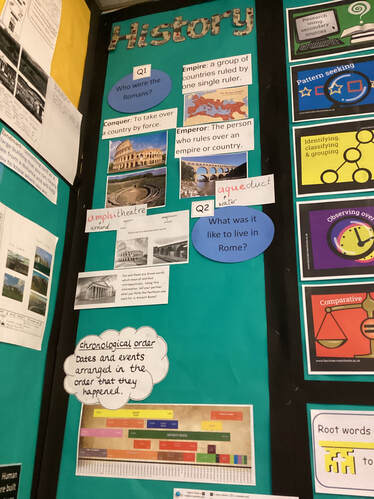
History - Romans
Year 4
History - Vikings
Year 5
Year 6
History - Windrush Generation
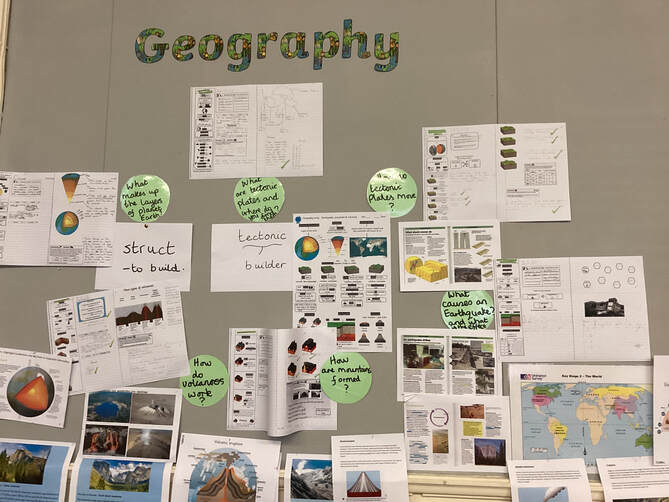
Geography - Earthquakes, mountains & volcanoes
History - Windrush Generation

